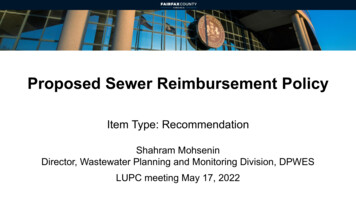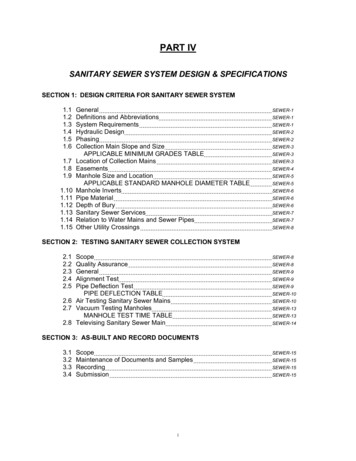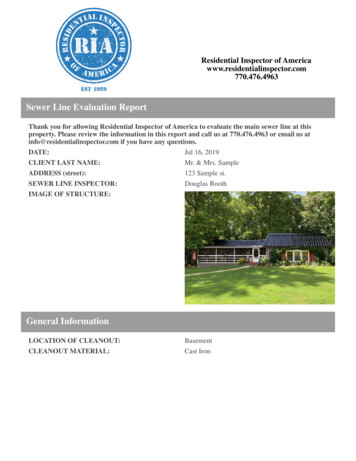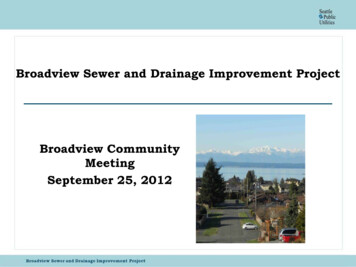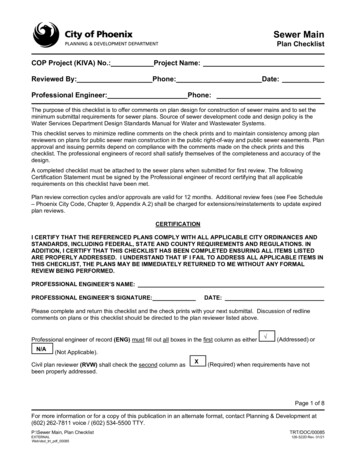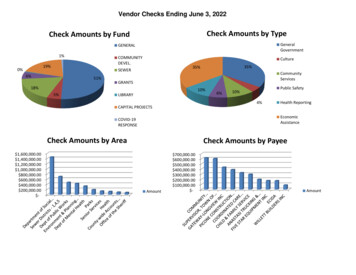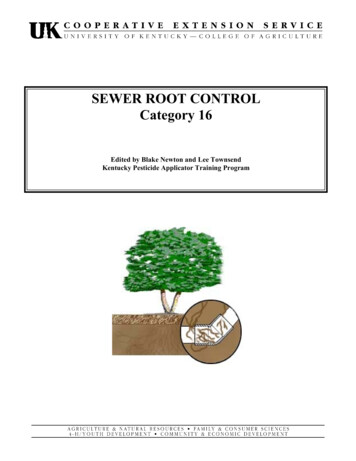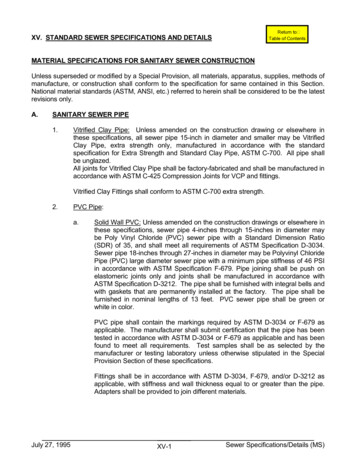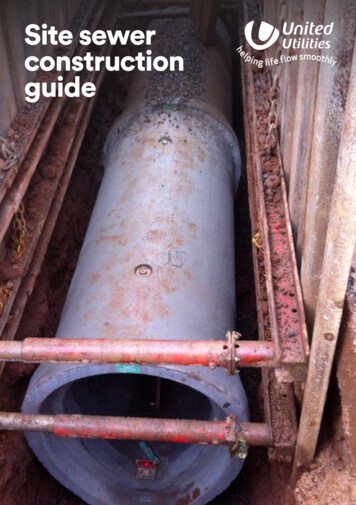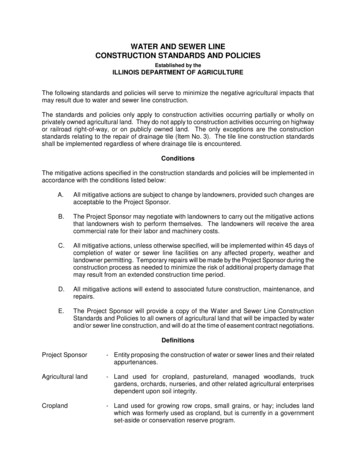
Transcription
WATER AND SEWER LINECONSTRUCTION STANDARDS AND POLICIESEstablished by theILLINOIS DEPARTMENT OF AGRICULTUREThe following standards and policies will serve to minimize the negative agricultural impacts thatmay result due to water and sewer line construction.The standards and policies only apply to construction activities occurring partially or wholly onprivately owned agricultural land. They do not apply to construction activities occurring on highwayor railroad right-of-way, or on publicly owned land. The only exceptions are the constructionstandards relating to the repair of drainage tile (Item No. 3). The tile line construction standardsshall be implemented regardless of where drainage tile is encountered.ConditionsThe mitigative actions specified in the construction standards and policies will be implemented inaccordance with the conditions listed below:A.All mitigative actions are subject to change by landowners, provided such changes areacceptable to the Project Sponsor.B.The Project Sponsor may negotiate with landowners to carry out the mitigative actionsthat landowners wish to perform themselves. The landowners will receive the areacommercial rate for their labor and machinery costs.C.All mitigative actions, unless otherwise specified, will be implemented within 45 days ofcompletion of water or sewer line facilities on any affected property, weather andlandowner permitting. Temporary repairs will be made by the Project Sponsor during theconstruction process as needed to minimize the risk of additional property damage thatmay result from an extended construction time period.D.All mitigative actions will extend to associated future construction, maintenance, andrepairs.E.The Project Sponsor will provide a copy of the Water and Sewer Line ConstructionStandards and Policies to all owners of agricultural land that will be impacted by waterand/or sewer line construction, and will do at the time of easement contract negotiations.DefinitionsProject Sponsor- Entity proposing the construction of water or sewer lines and their relatedappurtenances.Agricultural land- Land used for cropland, pastureland, managed woodlands, truckgardens, orchards, nurseries, and other related agricultural enterprisesdependent upon soil integrity.Cropland- Land used for growing row crops, small grains, or hay; includes landwhich was formerly used as cropland, but is currently in a governmentset-aside or conservation reserve program.
Water or Sewer Line - Includes water transmission and distribution lines, sewer trunk lines,sewer gravity flow lines, interceptors, or force mains and any relatedappurtenances.Landowner- Person(s) responsible for making decisions regarding the restoration ofthe land adversely impacted by a water or sewer line.Prime Farmland- Agricultural land comprised of soils that are defined by the USDA NaturalResources Conservation Service as being "Prime" soils (generallyconsidered the most productive soils with the least input of nutrients andmanagement).Right-of-Way- Includes the permanent and temporary easements that the ProjectSponsor acquires for the purpose of constructing water or sewer linesacross privately owned land.WATER AND SEWER LINE CONSTRUCTION STANDARDS AND POLICIES1.2.Water and Sewer Line DepthA.All water and sewer lines which are placed in trenches 24 inches in width or less will beburied with a minimum of 42 inches (60 inches are suggested by the IllinoisDepartment of Agriculture) of top cover where they cross cropland.B.All water and sewer lines that are placed in trenches greater than 24 inches in width willbe buried with 60 inches of topcover where they cross cropland.C.In terrain where bedrock prevents the placement of any water or sewer lines at thedepths specified in 1.A. or 1.B. above, the water or sewer lines will be buried as deep asis practicable and feasible.Topsoil ReplacementThe following standards apply only when water and sewer lines are buried in trenchesthat are greater than 24 inches wide.A.The actual depth of the topsoil, will first be stripped from the area to be excavated for awater or sewer line trench, all bore pits, and other areas of excavation.B.All subsoil material that is removed from the trench will be placed in a second stockpilethat is separate from the topsoil stockpile.C.In backfilling the trench and other excavated areas, the stockpiled subsoil material will beplaced back into the trench first. The topsoil will be replaced last so that it remains the toplayer of soil.D. The topsoil and subsoil must be replaced within the trench and other excavated area so thatafter settling occurs, the land's original contour (with an allowance for settling) will beachieved.2
E. The subsoil displaced by the water or sewer line must be hauled off the landowner'spremises or disposed of on the landowner's premises at a location that is acceptable to thelandowner.3.Repair Of Damaged Tile LinesIf underground drainage tile is damaged by water or sewer line construction, it must berepaired in a manner that assures the tile line's proper operation at the point of repair. Thefollowing standards and policies shall apply to the tile line repairs.A.The Project Sponsor will endeavor to locate all tile lines prior to water or sewer lineconstruction so repairs can be made if necessary. The Project Sponsor will contactaffected landowners/tenants for their knowledge of tile line locations prior to any water orsewer line construction. All identified tile lines will be flagged to alert construction crewsto the possible need for tile line repairs.B.All tile lines shall be repaired with materials of the same or better quality as that whichwas damaged.C.All damaged tile lines shall be immediately and temporarily repaired until such time thatpermanent repairs can be made.D.Where tile lines are severed by water or sewer line trenches, non-compactable supportmust be added around the repaired tile lines in accordance with the attached detaildrawings.1.Within the trench, maximum rock size shall be 1 1/2 inch river gravel or 1 inchcrushed stone for backfill under all tile lines.2.There must be a minimum of one foot of separation between a tile line and thewater or sewer line whether the line passes over or under the tile line.3.In no instance will the grade of a tile line be changed.E.Heavy construction equipment working within a water or sewer line right-of-way maycrush shallow drainage tile. All tile lines intersecting the water or sewer line trench will beprobed laterally for their entire length within the water or sewer line right-of-way to checkfor damaged tile. Probing must occur immediately prior to the permanent repair of anysevered tile lines. If tile lines are found to be damaged, they must be repaired so theyoperate as well after construction as before construction began, and in a manner that isacceptable to the landowner.F.All permanent tile line repairs must be made within 14 days of the date the damageoccurred, weather and landowner permitting. If the landowner elects to make his/herown tile repairs, such damage payments will be negotiated with the Project Sponsor andmust also be made within 14 days of the date of the completed repair work.G.The Project Sponsor will remain liable for a period of three (3) years following thecompletion of the water or sewer lines to ensure that all tile line repairs do not fail. TheProject Sponsor will not be responsible for tile line repairs that the Project Sponsor paysthe landowner to perform.3
Part 642 – National Engineering HandbookNational Standard Material SpecificationsMaterial Specification 592—Geotextile1. ScopeThis specification covers the quality of geotextiles.2. General requirementsFibers (threads and yarns) used in the manufactureof geotextile shall consist of synthetic polymerscomposed of a minimum of 85 percent by weightpolypropylenes, polyesters, polyamides,polyethylene, polyolefins, or polyvinylidenechlorides. They shall be formed into a stablenetwork of filaments or yarns retaining dimensionalstability relative to each other. The geo-textile shallbe free of defects and conform to the physicalrequirements in tables 592–1 and 592–2. Thegeotextile shall be free of any chemical treatment orcoating that significantly reduces its porosity. Fibersshall contain stabilizers and/or inhibitors to enhanceresistance to ultraviolet light.Thread used for factory or field sewing shall be ofcontrasting color to the fabric and made of highstrength polypropylene, polyester, or polyamidethread. Thread shall be as resistant to ultravioletlight as the geotextile being sewn.3. ClassificationGeotextiles shall be classified based on the methodused to place the threads or yarns forming the fabric.The geotextiles will be grouped into woven andnonwoven types.Woven—Fabrics formed by the uniform and regularinterweaving of the threads or yarns in twodirections. Woven fabrics shall be manufacturedfrom monofilament yarn formed into a uniformpattern with distinct and measurable openings,retaining their position relative to each other. Theedges of fabric shall be selvedged or otherwisefinished to prevent the outer yarn from unraveling.relative to each other when bonded by needlepunching, heat, or resin bonding. The use ofnonwovens other than the needle punchedgeotextiles is somewhat restricted (see note 3 oftable 592–2).4. Sampling and testingThe geotextile shall meet the specified requirements(table 592–1 or 592–2) for the product style shownon the label. Product properties as listed in the latestedition of the "Specifiers Guide," GeotechnicalFabrics Report, (Industrial Fabrics AssociationInternational, 1801 County Road BW, Roseville,MN 55113-4061) and that represent minimumaverage roll values, are acceptable documentationthat the product style meets the requirements ofthese specifications.For products that do not appear in the abovedirectory or do not have minimum average rollvalues listed, typical test data from the identifiedproduction run of the geotextile will be required foreach of the specified tests (tables 592–1 or 592–2)as covered under clause AGAR 452.236-76.5. Shipping and storageThe geotextile shall be shipped/transported in rollswrapped with a cover for protection from moisture,dust, dirt, debris, and ultraviolet light. The covershall be maintained undisturbed to the maximumextend possible before placement.Each roll of geotextile shall be labeled or tagged toclearly identify the brand, class, and the individualproduction run in accordance with ASTM D 4873.Nonwoven—Fabrics formed by a random placementof threads in a mat and bonded by heat-bonding,resin-bonding, or needle punching. Nonwovenfabrics shall be manufactured from individual fibersformed into a random pattern with distinct, butvariable small openings, retaining their position(210-VI-NEH, May 2001)592 - 1
National Standard Material SpecificationsPart 642 – National Engineering HandbookTable 592–1 Requirements for woven geotextilesPropertyTest methodClass IClass II & IIIClass IVTensile strength(pounds) 1/ASTM D 4632grab test200 minimum in anyprincipal direction120 minimum in anyprincipal direction180 minimum in anyprincipal directionElongation at failure(percent) 1/ASTM D 4632grab test 50 50 50Puncture(pounds) 1/ASTM D 483390 minimum60 minimum60 minimumUltraviolet light(% residual tensilestrength)ASTM D 4355150-hr exposure70 minimum70 minimum70 minimumApparent openingsize (AOS)ASTM D 4751As specified, butno smaller than0.212 mm (#70) 2/As specified, butno smaller than0.212 mm (#70) 2/As specified, butno smaller than0.212 mm (#70) 2/Percent open area(percent)CWO-02215-864.0 minimum4.0 minimum1.0 minimumPermitivity sec-1ASTM D 44910.10 minimum0.10 minimum0.10 minimum1/Minimum average roll value (weakest principal direction).2/U.S. standard sieve size.Note: CWO is a USACE reference.592 - 2(210-VI-NEH, May 2001)
National Standard Material SpecificationsPart 642 – National Engineering HandbookTable 592–2 Requirements for nonwoven geotextilesClass IIClass IIIClass IV 3/180 minimum120 minimum90 minimum115 minimumASTM D 4632 50 50 50 50Puncture (pounds)ASTM D 483380 minimum60 minimum40 minimum40 minimumUltraviolet light(% residualtensile strength)ASTM D 4355150-hr exposure70 minimum70 minimum70 minimum70 minimumApparent openingsize (AOS)ASTM D 4751As specifiedmax. #40 2/As specifiedmax. #40 2/As specifiedmax. #40 2/As specifiedmax. #40 2/Permittivity sec–1ASTM D 44910.70 minimum0.70 minimum0.70 minimum0.10 minimumPropertyTest methodClass ITensile strength(lb) 1/ASTM D 4632grab testElongation atfailure (%) 1/1/ Minimum average roll value (weakest principal direction).2/ U.S. standard sieve size.3/ Heat-bonded or resin-bonded geotextile may be used for classes III and IV. They are particularly well suited toclass IV. Needle-punched geotextiles are required for all other classes.(210-VI-NEH, May 2001)592 - 3
4.5.Rock RemovalA.The top 42 inches of a water or sewer line trench will not be backfilled with soil containingrocks that are larger than 3 inches in any dimension.B.If trenching, blasting, or boring operations are required through rocky terrain, suitableprecautions will be taken to eliminate the potential for rocks to become interspersed withthe soil material that is placed back in the trench.C.Rocks and/or soil containing rocks that are larger than 3 inches in any dimension mustbe hauled off the landowner's premises or disposed of on the landowner's premises at alocation that is mutually acceptable to the landowner and the Project Sponsor.Removal Of Construction DebrisAll construction-related debris and material will be removed from the landowner's property.(Note: Such material to be removed would include litter generated by the construction crews.)6.Compaction, Rutting, Fertilization, LimingA.7.When water and sewer lines are buried in trenches that are greater than 24 inches inwidth:1.Compaction will be alleviated on the trench and any adjacent work areas that aretraversed by construction equipment. Cropland will be ripped at least 18 inchesdeep and pasture and woodland will be ripped or chiseled at least 12 inches deep.2.Any other areas of the right-of-way which are traversed by construction equipmentand related vehicles will be ripped or chiseled at least 12 inches deep.3.At least 3 passes will be made over all lands to be ripped and/or chiseled.4.All cropland that has been disturbed by construction activities will be limed andfertilized where necessary in order to benefit the current and/or next year'sagricultural production or vegetative cover to control soil erosion.B.When water and sewer lines are buried in trenches less than 24 inches wide, all rightof-way that has been traversed by construction equipment and related vehicles will bechiseled at least 12 inches deep with at least 3 passes being made.C.All ripping and chiseling will be done at a time when the soils are dry enough for normaltillage operations to occur on undisturbed cropland adjacent to the areas to be tilled.Land LevelingA.The Project Sponsor will remain liable, for a period of two (2) years following thecompletion of a water or sewer line, to restore any right-of-way to its original elevationand contour should uneven settling occur or surface drainage problems develop due toinaccurate land leveling immediately following a water or sewer line's construction.B.The Project Sponsor will provide the landowners with a telephone number and addressthat may be used to alert the Project Sponsor of the need to perform additional landleveling services.4
8.9.Prevention Of Soil ErosionA.The Project Sponsor will work with landowners to prevent excessive erosion on landsdisturbed by construction. Reasonable methods will be implemented to control erosion.This is not a requirement, however, if the land across which a water or sewer line isconstructed is bare cropland that the landowner intends to leave bare until the next cropis planted.B.If the landowner and Project Sponsor cannot agree upon a reasonable method to controlerosion on the landowner's right-of-way, the Project Sponsor will follow therecommendations of the appropriate county Soil and Water Conservation District if thelandowner so requests.Repair Of Damaged Soil Conservation PracticesAll soil conservation practices (such as terraces, grassed waterways, filter strips, concretestructures, dams, etc.) that are damaged by water or sewer line construction will be restored toat least their pre-construction condition.10. Damages To Private PropertyA.With the exception of tile line repairs, the Project Sponsor will repair, replace, or pay torepair or replace damaged private property within 45 days, weather and landownerpermitting, after a water or sewer line has been constructed across any affected property.B.Similar relief for damages will be extended by the Project Sponsor for any constructionrelated damages that occur off of the established water or sewer line right-of-way.C.The Project Sponsor will remain liable to correct damages to private property beyond theinitial construction of a water or sewer line, to those damages incurred by futureconstruction, operation, maintenance, and repairs.11. Clearing Of Trees And Brush From The EasementA.If trees are to be removed from the right-of-way, the Project Sponsor will consult with thelandowner to see if there are trees of commercial or other value to the landowner.B.If there are trees of commercial or other value to the landowner, the Project Sponsor willallow the landowner the right to retain ownership of the trees with the disposition of thetrees to be negotiated prior to the commencement of land clearing.C.The Project Sponsor will follow the landowner's desires which are consistent with anyapplicable laws or ordinances regarding the disposal of trees, brush, and stumps of novalue to the landowner by burning, burial, etc., or complete removal from any affectedproperty.12. Interference With Irrigation SystemsA.If a water or sewer line intersects an operational (or soon to be operational) sprayirrigation system, the Project Sponsor will establish with the landowner an acceptableamountof time the irrigation system may be out of service.5
B.If an irrigation system interruption results in crop damages, either on the water or sewerline right-of-way or off the right-of-way, the landowner will be compensated for all suchcrop damages.C.If it is feasible and mutually acceptable to the Project Sponsor and the landowner,temporary measures will be implemented to allow an irrigation system to continue tooperate across land on which a water or sewer line is also being constructed.13. Ingress And Egress RoutesPrior to any water or sewer line construction, the Project Sponsor and the landowner will reacha mutually acceptable agreement on the route that will be utilized for entering and leaving thewater or sewer line right-of-way should access to the right-of-way not be practical or feasiblefrom adjacent segments of the water or sewer line right-of-way or from public highway orrailroad right-of-way.14. Temporary RoadsA.The location of temporary roads to be used for construction purposes will be negotiatedwith the landowner.B.If temporary roads must be constructed, they will be designed to not impede surfacedrainage soil erosion on or near the temporary roads will be minimized.C.Upon abandonment, temporary roads may be left intact through mutual agreement of thelandowner and the Project Sponsor.D.If the temporary roads are to be removed, the right-of-way upon which the temporaryroads are constructed will be returned to their previous use and restored to the same orbetter condition as existed prior to their construction.15. Weed ControlA.On any right-of-way over which the Project Sponsor has jurisdiction as to the surface useof such land (well heads, pump or lift stations, valve sites, etc.), the Project Sponsorwill provide for weed control in a manner that does not allow for the spread of weeds ontoadjacent lands used as cropland.B.The Project Sponsor will remain liable for the costs incurred by owners of land adjacentto surface facilities when the landowners must control weeds on their land which havespread from land accommodating water or sewer line surface facilities.16. Pumping Of Water From Open TrenchesA.In the event it becomes necessary to pump water from open trenches, the ProjectSponsor will pump the water in a manner that will avoid damaging adjacent agriculturalland. Such damages include, but are not limited, inundation of crops for more than 24hours and the deposition of sediment and gravel in fields, pastures, ditches, and anywater bodies or water courses.B.If it is impossible to avoid water-related damages as described in 16.A. above, theProject Sponsor will compensate the landowners for the damages or will correct the6
damages so as to restore the agricultural land, water courses, etc. to their pre-existingcondition.C.All pumping of water shall comply with existing drainage laws, local ordinances relating tosuch activities, and provisions of the Clean Water Act.17. Aboveground FacilitiesAboveground facilities shall be located so they will not be a hindrance to ongoing agriculturalactivities occurring on the lands adjacent to the facilities. First priority shall be made tolocating aboveground facilities on right-of-way that is not used as cropland. If this is notfeasible, such facilities shall be located so as to incur the least hindrance to the adjacentcropping operations (i.e., located in field corners or areas where at least one side is not usedfor cropping purposes).18. Advance Notice Of Access To Private PropertyA.The Project Sponsor will provide the landowner or tenant with a minimum of 24 hoursprior notice before accessing his/her property for the purpose of constructing a water orsewer line.B.Prior notice shall first consist of a personal contact or a telephone contact, whereby thelandowner or tenant is informed of the Project Sponsor's intent to access the land. If thelandowner or tenant cannot be reached in person or by telephone, the Project Sponsorwill mail or hand deliver to the landowner or tenant's home a dated, written notice of theProject Sponsor's intent. The landowner or tenant need not acknowledge receipt of thewritten notice before the Project Sponsor can enter the landowner's property.19. Reporting Of Inferior Agricultural Impact Mitigation WorkPrior to the installation of any water or sewer line, the landowners will be provided with anumber they can call to alert the Project Sponsor should landowners observe inferior workrelating to the agricultural impact mitigation work which is performed on their property.20. IndemnificationFor any water or sewer line installation, the Project Sponsor will indemnify all landowners, theirheirs, successors, legal representatives, and assigns from and against all claims, injuries,suits, damages, costs, losses, and expenses including legal fees resulting from or arising outof the construction, maintenance, removal, repair, use or existence of a water or sewer line,whether heretofore or hereafter constructed, including damage to a water or sewer line or anyof its appurtenances and the leaking of its contents, except where claims, injury, suits,damages, costs, losses, and expenses are caused by the negligence or intentional acts of thelandowners, their heirs, successors, legal representatives, and assigns.Construction\Water and Sewer Line Construction Stds.doc1009017
2. There must be a minimum of one foot of separation between a tile line and the water or sewer line whether the line passes over or under the tile line. 3. In no instance will the grade of a tile line be changed. E. Heavy construction equipment working within a water or sewer line right-of-way may crush shallow drainage tile.
